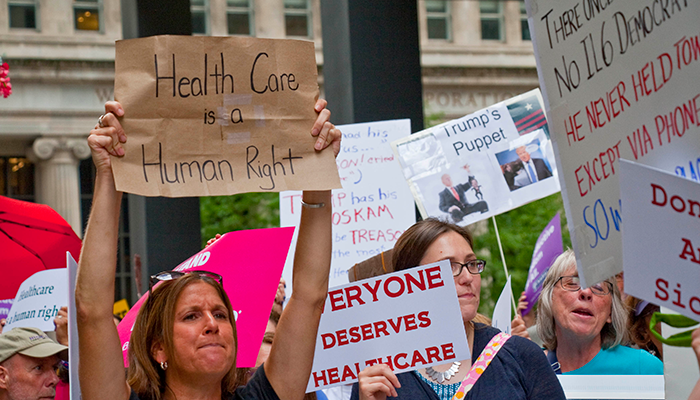In the US mid-term elections at the start of last week, one of the big campaign issues for the Democrats was moving towards a publicly funded healthcare programme for all.
The press has attributed the party’s call for ‘Medicare for all’ as the deciding factor in its victory over the Republicans to win the House of Representatives by 225 seats to 197.
And this is perhaps not a surprise considering polls leading up to the elections showed Americans’ dissatisfaction with health policy in their country.
In the summer a Reuters survey showed that 70% of Americans supported ‘Medicare for all’ - a national health insurance programme, currently only available to people over 65, younger people with disabilities and those with end-stage renal disease.
US health campaigning organisation the Kaiser Family Foundation concluded in March this year 59% of Americans were in favour of a single government healthcare scheme and 38% were opposed.
Until former president Barack Obama managed to get his Affordable Care Act into law in 2010 - ‘Obamacare’ as it is more widely known - many Americans didn’t have access to affordable healthcare insurance.
Despite the commitment to affordability and importance of individual contributions, the system as a whole is a very costly one, especially when benchmarked against international comparators.
In 2017, the country spent about $3.5 trillion – 18% of GDP – on health costs, which is more than twice the average among developed countries, according to the Committee for a Responsible Federal Budget.
Of this, about $1.5trn was publicly funded – which is about 8% of the economy. But still the rest of the total cost of healthcare in the US is paid by the private sector and by individuals.
Poor state of health
 Robert Yates, project director at the think-tank Chatham House, tells PF International the healthcare system is “so bad”. It’s “a joke in the international set-up”, he says.
Robert Yates, project director at the think-tank Chatham House, tells PF International the healthcare system is “so bad”. It’s “a joke in the international set-up”, he says.
Yates explains: “There are some US states that have a worse maternal mortality rate than Sri Lanka and Kazakhstan. It’s extraordinary that so many American women die in childbirth, because their health system does not meet their needs.”
He added that maternal mortality rates are “a real barometer of how your system is doing”.
A 2017 OECD report found that life expectancy in the US is slightly lower than the average of its 35 member states. It noted 32 of which have universal health coverage - ‘affordable’ healthcare for all. The US was not considered to have this.
Normally the more a country spends on their citizens’ health, the longer life expectancy, according to the OECD. But the report highlighted that it is not just about how much money is injected into health, but how the resources are used. It said: “There is a large variation in the link between changes in health spending and in life expectancy: in the United States, for example, health spending has increased much more than in other countries since 1995, yet life expectancy gains have been smaller.”
A US NGO The Commonwealth Foundation, in a report last year, ranked the US as the worst out of 11 advanced economies on safety, affordability and efficiency of healthcare.
It highlighted the US spent $9,364 per person on healthcare in 2016, whereas the UK, which ranked first on health performance overall, spent $4,094 per person. But the US falls still short and is an “outlier” because of the administrative inefficiency, the NGO concluded.
‘Despite spending nearly twice as much as several other countries, the country’s performance is lacklustre.’
The Commonwealth Foundation
One problem was patients and doctors said they wasted time with insurance claims. “Despite spending nearly twice as much as several other countries, the country’s performance is lacklustre,” the foundation's report said.
“The US healthcare system falls short, failing to deliver indicated services reliably to all who could benefit. In particular, poor access to primary care has contributed to inadequate prevention and management of chronic diseases, delayed diagnoses, incomplete adherence to treatments, wasteful overuse of drugs and technologies, and coordination and safety problems.”
One of the problems with the US healthcare system is it's expensive and complex – a 'patchwork system' made up of a mix of private providers, insurers and some federal-backed programmes, experts say.
Gerard Anderson, professor of health policy at Johns Hopkins University, says the system is the “most convoluted, confusing, dysfunctional system” he knows of, because the private and public players “do not work in conjunction with each other”.
Medicare, funded by the federal government, covers some 50 million elderly and disabled people, while Medicaid, a joint state and federal government programme, covers those living below the poverty line. Everyone else has to have private insurance. Most people get this through their employers, but an estimated 20 million don’t have insurance and pay out of their pocket if they need care, Anderson explains. Healthcare providers are generally private – both hospitals and small individual practices – which means the prices are high, and so is medication.
Getting better
 The Democrat Obama administration attempted to give everyone access to affordable health insurance with Obamacare but they still had to do this through private coverage providers. Although, Yates says the move was “a huge step towards universal care coverage, because [Barack Obama] made it compulsory that you had to take out health insurance”.
The Democrat Obama administration attempted to give everyone access to affordable health insurance with Obamacare but they still had to do this through private coverage providers. Although, Yates says the move was “a huge step towards universal care coverage, because [Barack Obama] made it compulsory that you had to take out health insurance”.
People had to take out health insurance under Obamacare by 31 January 2019 or face a fine or tax penalties. But the policy did ensure some providers gave affordable insurance.
Current president Donald Trump repealed part of the law meaning people without insurance can no longer be given tax penalties.
Trump’s administration is trying to “blow up” Obamacare but doesn’t have an alternative to put on the table, Yates says.
“But Republicans can’t cobble together an alternative plan”.
Robert Berenson, a fellow at the Urban Institute, an American think tank, says healthcare in the US is so expensive most people, even on the state programme, need some supplementary insurance to cover the fees that individuals still have to pay for treatment. The experts have estimated that some 20 million people remain uninsured and pay the high costs of care out of their own pockets - often avoiding seeking medical care until seriously ill, to avoid the paying high price of insurance.
This echoes the report by the Commonwealth Foundation, which stated that one-third of adults in the US reported they did not take a prescription drug, visit a doctor when ill or received recommended care in the past year because of the cost.
But by 2028, the federal government’s costs are estimated to increase to $2.9trn. The country pays more per person – almost $10,000 per person a year - than Australia, Canada, Denmark, France, Germany and the UK, according to the Committee for a Responsible Federal Budget.
We pay in the US approximately twice as much for the same service that exists in the UK or any other industrialised country
Gerard Anderson, professor of health policy, Johns Hopkins University
Anderson explains why the price of healthcare is so high in the US. “We pay in the US approximately twice as much for the same service that exists in the UK or any other industrialised country… It’s not that we get more hospital days or doctor visits, or better doctor visits or more drugs, it’s that we get more expensive services and drugs.”
There is also an “obsession with specialism”, Yates explains, which means healthcare providers are very good at treating cancer, for example, and tend to keep people in hospital and intensive care for longer than required – which also brings up the medical bill.
Care and drugs in the US are not regulated, so insurance providers and healthcare providers can set they prices they want.
The costs could perhaps be regulated – like they have been in Maryland since 1971 – but this is considered “un-American”, Anderson says.
Berenson from the Urban Institute, says: “Prices [of medical care and drugs] are what is driving costs.” He adds regulating prices is “very unlikely” at a federal level, although it could be possible at a state level.
Bernie Sanders, the US senator from Vermont, who proposed the ‘Medicare for all’ bill in September 2017, says the ‘single payer system’ - a single government run healthcare insurance programme - would make healthcare free for all with no ‘co-payments’, or additional costs individuals have to pay for their healthcare.
He said on his website : “The only long-term solution to America’s healthcare crisis is a single-payer national healthcare programme.”
According to Sanders, his plan will cost $6trn less than the current healthcare system over ten years. But analysis by the Mercatus Center at George Mason University in Virginia suggests ‘Medicare for All’ would cost $32.6trn over 10 years, requiring tax hikes.
Most advanced countries now have a universal publicly financed system, including most of Western Europe, Australia, Japan and chunks of Latin America. According to the World Bank, 33 developing countries have also embarked on a journey towards universal health coverage.
John Auerbach, the president of the Trust for America’s Health, a non-profit policy organisation, tells PF International publicly funded approach in the US is unlikely to happen in the next few years.
He explains: “It would be challenging to implement such a system nationally or even at a state level. In one of the 50 states, Vermont, there was an effort several years ago to try to move to a single payer state-based programme, and even though there was political support for that, it proved very complicated and expensive to do, at the state level. So, Vermont had to abandon that.”
It would also mean the federal government would have a big funding gap to fill – to cover the costs currently covered by the private sector – and this would most likely be through taxes. Americans don’t like taxes, Yates says – and it doesn’t seem that Trump is interested in raising taxes, given his tax reforms this year.
Anderson suggests to PF International: “In 1983, I testified in Congress in favour of single payer [system]. But it is no longer a viable alternative in the US. The main reason is the high healthcare cost in the US – of which 40% is paid for by the private sector, which represents a little over $1trn. For a single payer system, you’d have to increase taxes by $1trn, which is just not feasible.”
He added: “It’s depressing but I think it’s unfortunately real that we just can’t go to single payer because we won’t afford it – not that we can’t, but we won’t afford it because we won’t pay higher taxes.”
Berenson adds there is “no chance” of a publicly funded system for all to go ahead. “Our anti-government attitude, which is increasing not decreasing, and the politics in the US do not permit it.”
Yates also points out some people are benefiting from the current system - those working within the sector, such as hospitals, pharmaceutical companies and insurance. It is those people who “spend billions on advertising and propaganda trying to persuade the American people that a socialised healthcare system, like the rest of the world has, is like communism”, he says.
Moving to a single payer system would mean insurers would play a minimal role in health care – as in Europe – and they make a lot of money from the industry so would be likely to try and stop any change, the experts agree.
The Democrats winning control of the House doesn’t mean that ‘Medicare for All’ is likely to become a reality anytime soon.
It would most likely to be thrown straight out the window by the time it reaches the Senate, as this is controlled by Republicans.
Hope for the future
But Auberbach thinks efforts need to be made to reform the US’ healthcare system, despite all the challenges.
He says: “We should be guaranteeing a certain minimum level of public health services that every American can count on – rather than a patchwork quilt where public health provides certain kinds of preventive services in certain locations but not in others – we need to make sure that our public health system is robust.”
It is worth noting Democrats of the past, including presidents Franklin Roosevelt and Harry Truman, proposed systems like 'Medicare for all' but they never came to anything - partly because they didn’t agree what the universal care would look like.
But it is a possibility that whoever campaigns to be president in 2020 will lead with a pledge to change the health care system.
What the mid-term elections showed was there is will in the country for real change to the healthcare system - and perhaps for more public funds to be pumped into it.
Auerbach says: “We should set up a goal as a nation that every single person has access to affordable high quality care.
“We need to make sure that our public health system is robust and there is minimum guarantees for the American public that they can count on from the public health sector.”
Yates says it will be one “almighty battle” for the US to get something similar to the UK’s National Health Service but is “convinced” it will happen.
Some terms explained:
Medicare is a federal government health insurance programme for those who qualify by age (65+) or disability. It currently covers more than 50 million elderly or disabled in America.
It was created in 1965 and made healthcare in the US a universal right – for those over 65. There are different plans, which may cover hospital stays, doctors’ services and medical supplies, or prescriptions. As a beneficiary, you may still need to pay certain out-of-pocket costs, such as premiums, deductibles, co-payments or co-insurance.
The Affordable Care Act or ‘Obamacare’ on the other hand, is a reform legislation with several purposes, including extending health coverage to those who otherwise can’t afford it and requiring health-care plans meet certain minimum coverage standards. It basically ensures that everyone has access to ‘affordable’ care by regulating insurance, to make it affordable. Obamacare is still provided through private insurers and not run by the government.
Medicaid, for those who are poor and can’t afford any coverage, is a social security programme, like food stamps, and is a joint federal government and state initiative. It was signed alongside Medicare in the 60s and it administered at a state level, which means there is some variation of coverage across the country.
Universal health coverage: an SDG target and something many countries have already moved towards. The World Health Organization describes it as “ensuring that all people have access to needed health services of sufficient quality to be effective while also ensuring that the use of these services does not expose the user the financial hardship.”














